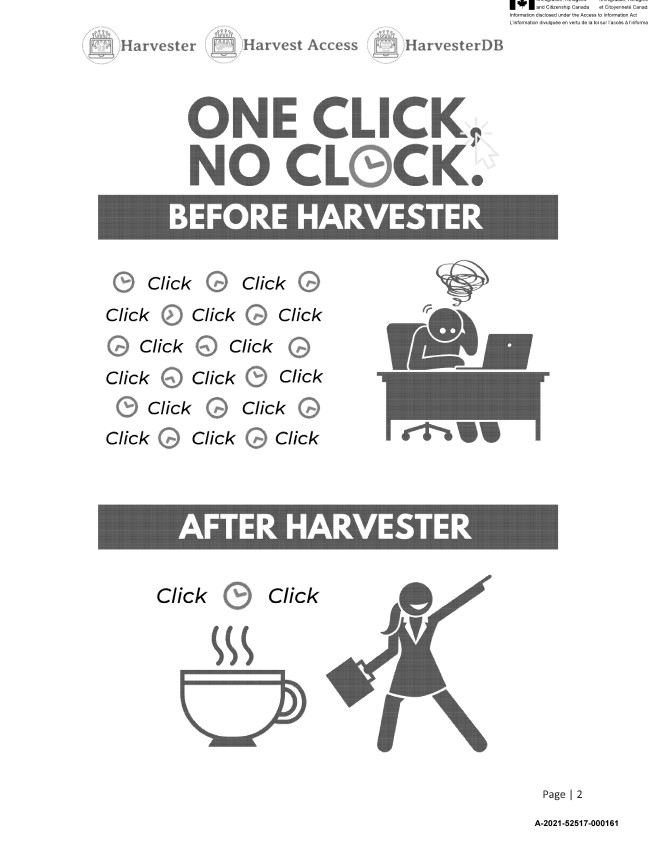We have re-produced IRCC’s Harvester user guide from 2021 below (with additional redactions added to preserve passwords that were likely erroneously disclosed).
Harvester Program Guide_Redacted 2_Redacted FINAL
What is Harvester?
Per page 5 of the PDF, it is an automation tool that downloads eDOCs from GCMS and organizes (read: reorganizes) the file using clear detailed names. The use of Harvester has improved productivity in pre-assessment by over 25% with minimal training.
Like Chinook (and compatible with Chinook), it also uses an Excel interface and Microsoft Access. Documents are harvested in silos, allowing an Officer to secure, control, and monitor access to a file. Reading between the lines, the use of Microsoft Access also allows all documentation to be displayed on one horizontal screen (to be used , alongside GCMS, and Chinook in a streamlined way. 7-zip is used to encrypt the documentation and similar to Chinook there’s a deletion system after use. Importantly, there appears to be added security functions on who can access the documents and also a trail of records for auditing. I suspect that this could come in handy in future litigation with respect to whether documentation was considered or not. Some docs are excluded from Harvester – either purposely by an Officer where the visa officer does not need to review said doc OR if the harvest does not succeed. I was not able to gleam from my reading where harvests are unsuccessful but one must assume there would be some tech explanation.
Much like Chinook, it appears quite innocuous on the face. It speeds up assessment, heck even I could use a Harvester download and saving (automating) the organization of a file before I review – tasks we often leave to legal assistants and case managers.
However, there may me more than meets the eye. We’re getting a clearer picture of what the Officer actually sees in front of them when they render a decision. What the Chinook 3+ Platform looks like, the various tools and prompts that may or may not be providing information to guide a decision being rendered. Harvester is another one.
Takeaways
I would love feedback from our readers to see if they have any ideas but at this stage, I am looking at a couple major ones.
- Does the way we name and number our files mean anything any more? We often are creative with the way we try and flag specific names or combine documents, but how does Harvester extract or parse this apart? Is Harvester used (usable) on all apps or just select types that are already streamlined online?
- How meaningful is the ability to view the documents on Microsoft Access. From my understanding Harvester replaces the need to utilize other applications such as possibly PDF, Word, or an image reviewer. What does that mean for the way an Officer scrolls through various documents. What other tools does Microsoft Access provide in this regard (I’ve only watched a few online videos so maybe some of the tech-minded can advise);
- Why are there silos created for multiple applications? I am concerned again about this ability to string together various applications and harvest all at the same time. Is there a purpose to this? It would make very much sense within a family of applicants to be able to do so, but why would multiple applications un-related be harvested unless its simply to get the files ‘set up’ for review.
Would love for some of you to take a look at Harvester and let us know what you think!

